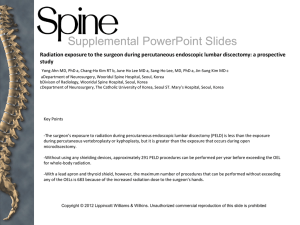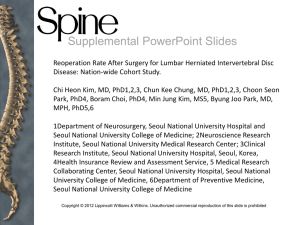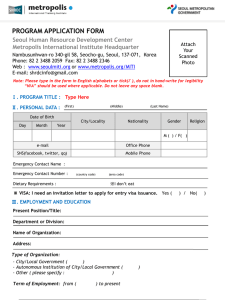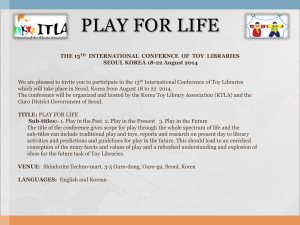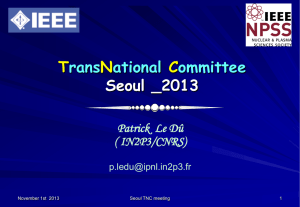Seoul Development Institute
advertisement
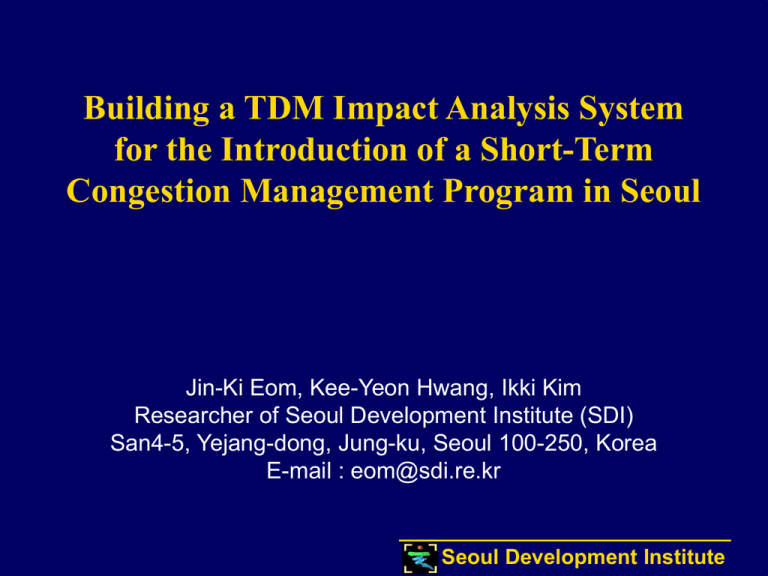
Building a TDM Impact Analysis System for the Introduction of a Short-Term Congestion Management Program in Seoul Jin-Ki Eom, Kee-Yeon Hwang, Ikki Kim Researcher of Seoul Development Institute (SDI) San4-5, Yejang-dong, Jung-ku, Seoul 100-250, Korea E-mail : eom@sdi.re.kr Seoul Development Institute Outline SCMP(Sort-term Congestion Management Program) SECOMM(Seoul Congestion Management Model) SECOMM Case Study Conclusion Seoul Development Institute Why Seoul needs SCMP ? Short-term Congestion Management Program Seoul has been known for the notoriety of its severe traffic congestion. In order to mitigate the congestion problems, the transportation policy of Seoul Metropolitan Government had been mainly focused on the supply of transportation systems until the early 1990’s. The sharp decrease of investment on transportation infrastructures followed by recent economic recession. The massive implementation of subway system does not reduce auto rider-ship as much as we expected. Seoul Development Institute 2. SCMP (Short-term Congestion Management Program) 1. Setting up Short-term Target of Traffic Management 2. Selecting TDM Programs to Reduce the Excessive Auto Demand 3. Building a Methodology for Forecasting the Expected Impacts of Programs(ex. SECOMM) 4. Monitoring Traffic Conditions Regularly Seoul Development Institute 3. SECOMM (SEoul COngestion Management Model) Assumption Structure of the SECOMM Mode Split Model Assignment Model Link Travel Speed Adjustment Function Seoul Development Institute Assumption The assumptions of SECOMM are as follows Mode split and route choice are variable while trip generation and trip distribution are not in short-run Investment is fixed in the short-run Seoul Development Institute Structure of the SECOMM Household Travel Survey Travel Speed Survey Data in Seoul Data Clearance Short-term Traffic Management Target Modal Split Model (A-Logit) EMME/2 Macro Setting TDM Alternatives Forecasting Prospective Implement Alternatives Monitoring/Analysis If Satisfy the goal of Strategy No Yes END Seoul Development Institute Data Requirements Data Format Date Source ’96 Seoul Metropolitan O/D by Modes - Peak Hour and Non-Peak Hour Day/hour 1997.10 – 1998.3 ’96 Household Travel Diary Survey - Travel Preference and Individual 1 week Trip Data (Wednesday) Day 1997.10 – 1998.3 Seoul Metropolitan Road Network Data Transit Route and Network Data Hour 1996.11 – 1998.4 A Day Traffic Volume at Namsan #1.3 Tunnel Hour 1996.11 – 1998.4 Bus & Subway Ridership Data & Traffic Volume Survey Data in Seoul Hour 1996, 1997 Traffic Speed Survey Data in Seoul Hour 1996, 1997 Seoul Development Institute Seoul Development Institute Seoul Development Institute Seoul Metropolitan Government Seoul Metropolitan Police Seoul Metropolitan Government Index Trip /Travel Pattern Network Traffic Volume Speed Seoul Development Institute Process of Building Mode Split Model Variable Selection Data Clearing Generating Unknown Travel Time & Cost of Alternative Travel Modes Mode Split of Cleared Data Set Building Data File (Convert Data into A-Logit Format) Building Control File 1: MNL Method / 2 : Nested Method Variables Adjustment A-Logit Run Satisfy Stopping Criteria No Yes Utility Functions and Parameters are Set Seoul Development Institute Logit Model (1) Nested Tree for Each Alternative Car Bus Subway Taxi Car Taxi Bus Car Bus Subway Subway Taxi Car Bus Subway Taxi Ui Vari 1TTimei 2TCosti Ui Var i Ttime i TCost i 1 2 : : : : : utility function of mode i constant(except bus) of mode i total travel time(min) of mode i total travel cost(won) of mode i Coefficient of independent variable Seoul Development Institute Logit Model (2) The Parameter Values and T-Values of Nested-Logit Models Variable Cost Time Auto Dummy Parameter Value -0.000175 -0.03417 -0.6845 T-Value -5.6 -21.9 -5.9 -14.3 -8.7 21.6 - Parameter Value -0.00023 -0.03988 -0.9568 -0.9200 -1.979 0.5084 0.3897 T-Value -5.0 -20.9 -4.1 -14.1 -6.4 7.9 5.1 Parameter Value 0.000083 -0.03753 0.0717 -0.8515 -1.7600 0.0445 11.61 T-Value 2.8 -21.8 0.3 -14.2 -8.4 2.8 9.9 Parameter Value -0.000124 -0.03472 -0.6525 -0.8361 -2.173 0.8391 - T-Value -3.3 Value -21.8 -5.5 Subway Dummy Taxi Dummy 1 2 -0.8317 -2.211 0.9065 - -14.3 -9.1 16.8 _ 2 0.2434 0.1078 0.2489 0.1143 0.2469 0.1119 0.2440 0.1085 2 - Seoul Development Institute Assignment Process Traffic Index Adjustment Pre-Network Pre-Network Build Build Trip Index Trip Index Highway Highway Network Network Transit Network Network -Transit Bus, Subway - Bus, Subway `96 Traffic Census Traffic Census - `96 Peak hour O/D - Peak hour O/D -1 Day O/D - 1 Day O/D Management Region Management Region - Link, Zone - Link, Zone Link Group LinkVolume Group - Speed, - Speed, Volume Traffic Traffic Management Management Index Confirm Index Confirm Model Calibration All Mode OD Mode (PeakAll Hour / 1 OD Day) (Peak Hour / 1 Day) Auto OD Auto OD Taxi OD Taxi OD Vehicle Occupancy Vehicle Occupancy for Each Mode for(PCU Each)Mode (PCU ) Highway Highway Assignment Assignment Assignment Result for Assignment Result for Each Link Each Link (Volume, Speed, Time) (Volume, Speed, Time) No Subway OD Subway OD Transit OD Transit OD Link Link Performance Performance Function Function Highway OD Highway OD Highway Highway Network Network Bus OD Bus OD To Apply To Apply Weight Weight Factor Factor (Wait time (Wait time Access time, Access time, Boarding/ Boarding/ Alighting Alighting time) time) To Compare Present To Compare Present Transit Transit Network Network Transit Transit Assignment Assignment Assignment Result Assignment Result for Each Route for Each Route (Travel Time,Cost) (Travel Time,Cost) No Yes STOP STOP Seoul Development Institute Process of Predicting Link Travel Speed Using the adjustment factor, We can predict link travel speed S Lobs f est SL Slpre Slest f Where, S Lobs : Observed Average Speed of Link Group L S Lest : Estimated Average Speed of Link Group L to Use Estimated Link Volume from Assignment Result S lpre : Predicted Average Speed of Link l f : Adjustment Factor Seoul Development Institute 4. SECOMM Case Study Study Title : Impact Analysis of Gasoline Tax Increase Study Process Structure of Emme/2 Macro Study Results Seoul Development Institute Study Process 0. Initiation Building Mode Split Model Network Calibration Before Tax Increse Variable Parameter Input Network Calibration Results Saving 1. Gasoline Tax Increase 2. New Mode Split Ratio Calculation Using Parameters of Mode Split Model 3. Rebuilding Trip O/D of Each Mode 4. Run Assignment Auto-Assignment Transit-Assignment Saving Automobile Travel Time Saving Transit Travel Time Adjust factor 5. New Mode Split Ratio Calculation Using Parameters of Mode Split Model 6.Saving Difference of Mode Split Ratio 7.If Satisfy Stoping Conditions No Yes S TOP Seoul Development Institute Structure of Emme/2 Macro Emme/2 Macro TREE Emme/2 Macro TREE 0) Main Macro 1) Initialized Macro 2) Assigment Macro 1) Submacro 3) Time/Cost Calclation Macro 4) Mode Split Calibration Macro 5) Rebuild Trip Macro 2) 3) Submacro 4)... Submacro Sub-submacro Seoul Development Institute Case Study Results (1) The Speed Changes by Gasoline Tax Increase Average Speed (km/h) Category Current Speed Mileage Tax Charging $0.1 / l l Increase $0.2 / l l Increase $0.3 / l l Increase Speed Change Rate Speed Change Rate Speed Change Rate CBD 20.18 20.36 +0.2 0.9 20.39 +0.2 1.0 20.61 +0.4 2.1 Arterial 23.97 24.21 +0.2 1.0 24.34 +0.4 1.5 24.64 +0.7 2.8 Urban Highway 42.54 43.08 +0.5 1.3 43.53 +1.0 2.3 44.18 +1.6 3.9 Total Average In Seoul 25.19 25.33 +0.1 0.6 25.72 +0.5 2.1 26.10 +0.9 3.6 Seoul Development Institute Case Study Results (2) Auto-Mode Split Ratio Changes Resulting from Gasoline Tax Increase 21.0% Before After (the stable stage) 20.5% $0.1/L $0.2/L 20.0% $0.3/L 19.5% 19.0% 18.5% iteration 0 After (the first stage) 1 2 3 4 5 6 Seoul Development Institute Monitoring Data Response to Oil Price Increased 200 0.6 100 0.4 0 0.2 -100 0 -200 -0.2 -300 -0.4 0 5 10 15 20 25 30 35 40 45 50 55 60 <Response of Car to OIL_P> 0 5 10 15 20 25 30 35 40 45 50 55 60 <Response of SPEED to OIL_P> Seoul Development Institute Case Study Results (3) Peak Hour Auto Volume Changes Resulted by Gasoline Tax Increase Before $0.1 / l l Increase $0.2 / l l Increase $0.3 / l l Increase Peak Hour Automobile Volume (Vehicle/hour) 275,491 270,493 268,329 262,420 Decreasing Volume (%) - -4,998 (-1.8) -7,162 (-2.6) -13,071 (-4.8) Seoul Development Institute 5. Conclusions SECOMM is a TDM impacts analysis system integrating mode choice model and trip assignment model in a module and iterating the interactions between them until the stop conditions are accomplished. Using SECOMM, we can quickly forecast the impacts of TDM therefore, we can implement SCMP in Seoul. To enhance the usefulness of SECOMM, there are several things to be done: checking the estimated results of SECOMM through continuous monitoring on traffic situation in Seoul updating the O-D data at least every 5 years updating the network and travel behavior data Seoul Development Institute
